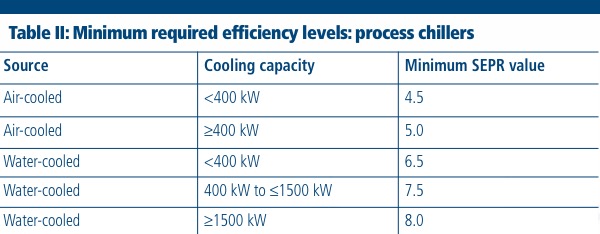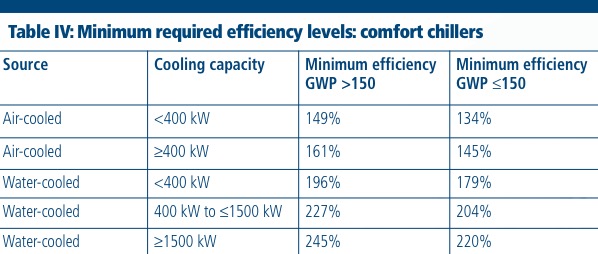This has not gone unnoticed by lawmakers and, as part of the latest phase of amendments to the European Commission’s EcoDesign Directive, introduced on 1 January 2018, industrial cooling and refrigeration equipment is required to meet new, stringent minimum levels of energy efficiency. Here, Richard Metcalfe, Sales Director at ICS Cool Energy, offers an overview of the changes and key action points for industrial end users.
In short, any new industrial cooling equipment entering the market must now meet new minimum energy performance standards (MEPS) according the type and size of the chiller. The changes affect two product groups (also known as lots): Lot 1, which covers refrigeration and freezing equipment, including medium and low-temperature process chillers and condensing units; and Lot 21, which includes high-temperature process chillers, condensing units and comfort chillers. However, these will not be the only long-term changes to affect cooling equipment, as the newly introduced 2018 MEPS are set to become even more stringent in January 2021.
What are MEPS and why are they important?
The annual cost of running industrial cooling and refrigeration systems can often turn into a five-figure sum during the course of a year. Operational costs are exacerbated by old or inefficient equipment, many of which would not come near the efficiency standards set out earlier this year. MEPS are split into two main categories, one for process chillers and one for comfort chillers.
Process chillers: Process chillers must meet new Seasonal Energy Performance Ratio (SEPR) metrics, which are calculated using part-load efficiency levels and expressed as a ratio (Table I).

SEPRs are the most relevant values for manufacturers and industrial end users to be aware of. The minimum efficiency levels products need to achieve are as follows. However, they may differ depending on the type of chiller (air- or water-cooled) and the rated cooling capacity (Table II).

Comfort chillers: Comfort chillers must meet new Seasonal Energy Efficiency Ratio (SEER) values. This is the overall energy efficiency ratio of the comfort chiller for the cooling season, which is calculated using the part-load efficiency and expressed as a percentage (Table III).

Again, the minimum efficiency levels that products need to achieve differs depending on whether they’re an air- or water-cooled chiller, as well as the rated cooling capacity and the Global Warming Potential (GWP) or the refrigerant used (Table IV). Common refrigerants such as R410a and R134a have a GWP well above 150.

Can I make my existing cooling equipment more energy efficient?
When it comes to deciding whether to repair or replace, it very much depends on the age and condition of the current process cooling equipment. If the chiller in question is fairly new, then immediately replacing it is likely to be out of the question. Here, the best policy would be to implement a Planned Preventive Maintenance (PPM) contract to pick up any red flags and ensure the chiller is kept at maximum operational efficiency for its full working life. This will not only minimise the risk of downtime, but also reduce reactive maintenance costs.
However, if the chiller is reaching the end of its operational life, it may be a false long-term economy to implement an ongoing repair and maintenance plan as the lower material cost of replacement parts would be offset by sustained high running costs.
Will the legislation increase equipment cost?
More often than not, there is a perception among manufacturers that high efficiency equipment equates to a high cost; but, that’s not always the case and opinions need to be shifted. For smaller manufacturers and SMEs, accessing the necessary capital has often been difficult; however, there are initiatives in place that are dedicated to providing financial support to SMEs seeking to fund energy efficient equipment.
One such example is the Carbon Trust’s Green Business Fund, which can offer grants to cover up to 15% of the equipment cost, up to a value of £5000. As a Carbon Trust-accredited supplier, 2018-compliant process cooling equipment — such as the i-Chiller and i-Chiller HE from ICS Cool Energy — can be purchased using Green Business Funding.
Another option is to undertake an equipment hire agreement. Contracts range from a short-term basis to long-term hire. This option allows all costs to be managed through one monthly all-inclusive payment, which not only covers the cost of the process cooling equipment, but ongoing maintenance costs and contingency breakdown cover.
One significant benefit of a long-term hire agreement is that the responsibility for compliance lies with the company hiring the cooling equipment, rather than the end user. However, as with a capital sales purchase, compliance only affects new products manufactured from 1 January 2018 onwards.
Long-term benefits
Ultimately, the EcoDesign Directive’s main aim is to reduce energy consumption. Energy consumption not only equates to carbon, but money as well; and the bottom line is that a reduction in energy consumption will directly reduce monthly operating costs for manufacturers. Although the enforced changes to industrial cooling may seem steep, there are many far-reaching long-term benefits from a financial, environmental and sustainability perspective. Yes, there is a lot of information to digest; however, the changes can easily be broken down in to a manageable plan of action.
By working closely with a temperature control specialist such as ICS Cool Energy, UK manufacturers can navigate any uncertainty and start reaping the rewards that the new legislative changes will offer.
